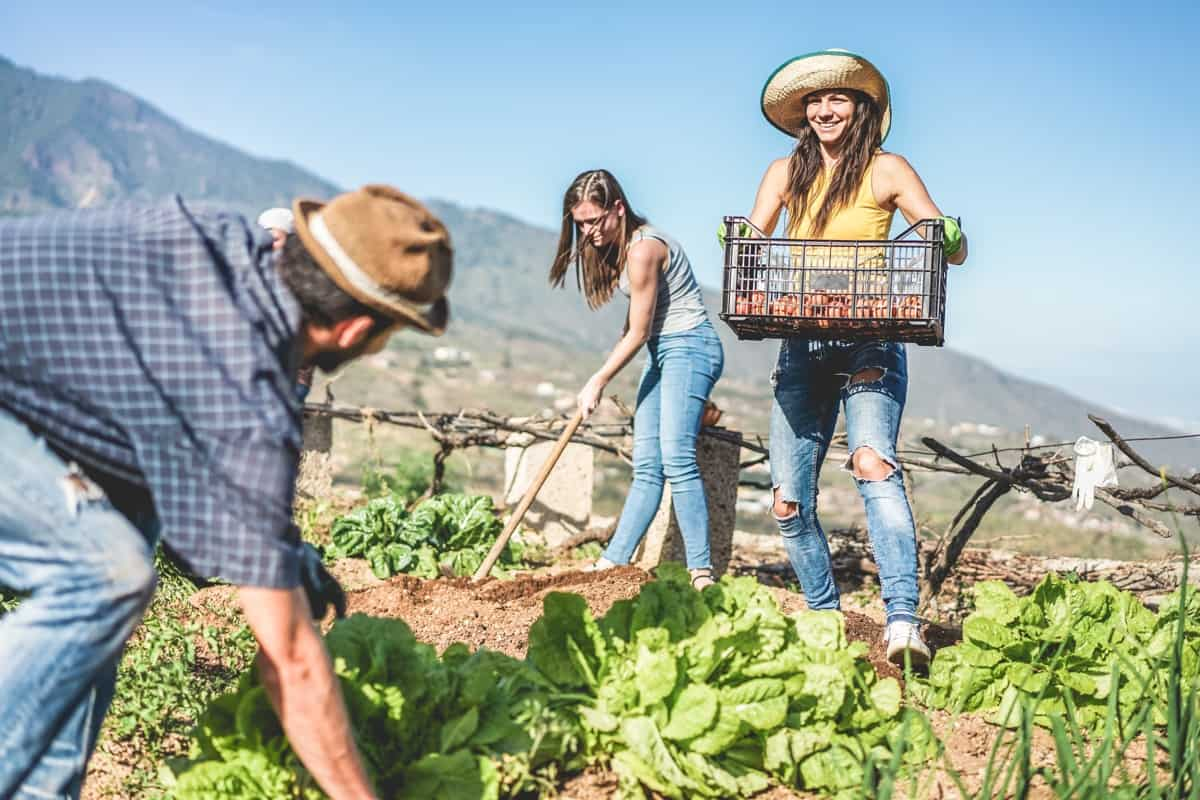Community-supported Agriculture (CSA) is an alternative to farming that has gained popularity in recent years. It is a system where farmers and consumers collaborate to create a mutually beneficial relationship. Here, we will explore the benefits of CSA and delve into farmers’ crucial role in this innovative approach to agriculture.

What is Community-supported Agriculture (CSA)?
Community-supported Agriculture (CSA) is a unique agricultural model that connects farmers directly with consumers. In a CSA, individuals or families become members of a local farm by buying a share of the farm’s produce at the beginning of the growing season. This upfront payment provides farmers with the necessary funds to cover their expenses.
Members will receive a supply of fresh, locally grown food regularly throughout the growing season, including fruits, vegetables, herbs, eggs, and dairy products. CSA promotes sustainable farming practices, fosters community involvement, and provides consumers access to fresh, seasonal, and high-quality produce. It is an excellent way to support local farmers and enjoy the benefits of locally sourced food.
Benefits of Participating in Community-supported Agriculture
Firstly, it allows individuals to support local farmers and promote sustainable agricultural practices. By joining a CSA, consumers gain access to fresh, locally grown produce, which is often more nutritious and flavorful than store-bought alternatives. Additionally, CSA members can develop a closer connection with their food and the farmers, fostering a sense of community.
Moreover, participating in CSA programs helps reduce the environmental impact of food production by minimizing transportation and packaging. Overall, engaging in CSA promotes healthier eating habits, supports local economies, and contributes to a more sustainable future.
How to Find a Community-supported Agriculture Program Near You
To find a Community-supported Agriculture (CSA) program near you, search online directories such as LocalHarvest.org or EatWellGuide.org. These websites provide comprehensive listings of CSA programs across the country. Search by location and filter the results based on specific preferences, such as organic or sustainable farming practices.
In case you missed it: How to Create a Community Garden: A Step-By-Step Guide for Beginners

Additionally, contact nearby farmers’ markets or natural food stores, as they often have information about local CSA programs. Another helpful resource is social media platforms like Facebook or Instagram, where many CSA programs promote their offerings. Utilizing these resources allows you to locate a CSA program and enjoy fresh, locally-grown produce.
Understanding CSA Share Options: Full vs. Half Shares
CSA (Community Supported Agriculture) share options allow individuals to support local farms and receive a portion of the harvest. When considering CSA shares, two common options are full and half shares. A full share typically suits larger households or those with a higher demand for fresh produce. It offers more vegetables, fruits, and other farm products. On the other hand, a half share is suitable for smaller households or individuals with a lesser need for produce. It provides a smaller quantity, ensuring the share is manageable and not wasted.
What to Expect in a Community-supported Agriculture Share
A Community-supported Agriculture (CSA) share is a program where individuals or families can purchase a seasonal membership from a local farm. By doing so, they receive a regular supply of fresh, locally-grown produce. Each week, members can expect a variety of vegetables, fruits, and sometimes herbs or flowers, depending on the farm and the season.
CSA shares often include common and unique produce items, allowing one to try new foods and expand one’s culinary horizons. Additionally, some CSA programs offer add-ons such as eggs, dairy products, or meat. Participating in a CSA share supports local farmers and promotes a healthier and more sustainable food system.
The Role of Farmers in Community-supported Agriculture
Crop Planning and Management: Farmers play a crucial role in planning and managing their crops to meet the needs of CSA members. They carefully select and cultivate various crops to provide a balanced and varied harvest throughout the season. This involves assessing the needs and preferences of their CSA members and ensuring a steady supply of fresh produce.
Harvesting and Distribution: Farmers are responsible for harvesting the crops at their peak ripeness and ensuring their timely delivery to CSA members. This requires efficient coordination and logistics to guarantee that the produce reaches the consumers in its freshest state. Farmers often establish pick-up points or organize home deliveries to ensure convenience for their CSA members.
In case you missed it: 13 Essential Garden Tools and Their Functions

Communication and Engagement: It is essential for the success of CSA programs. Farmers engage with their members through newsletters, farm visits, and social media updates, providing insights into their operations, sharing seasonal recipes, and fostering community. This direct connection between farmers and consumers creates a unique bond and promotes transparency in the food supply chain.
Community Engagement in Community-supported Agriculture
Community engagement is an integral part of CSA programs. By joining a CSA, individuals become part of a community of like-minded people passionate about supporting local agriculture and having a closer connection to their food sources. CSA members often have the opportunity to visit the farm, meet the farmers, and participate in farm-related activities such as harvesting, planting, or even attending workshops on sustainable farming practices. This engagement provides a deeper understanding of how food is produced and fosters a sense of community and shared responsibility.
The Environmental Impact of Community-supported Agriculture
Community-supported agriculture (CSA) is an agricultural model that aims to minimize the environmental impact of conventional farming practices. By connecting consumers directly with local farmers, CSA promotes sustainable farming methods like organic cultivation, crop rotation, and minimal pesticide use. This approach minimizes soil erosion, water pollution, and the carbon footprint associated with transportation.
Additionally, CSA encourages biodiversity by supporting small-scale farmers who often prioritize heirloom varieties and traditional farming techniques. By fostering a closer relationship between consumers and producers, CSA provides fresh and nutritious food and helps mitigate the environmental impact of agriculture in local communities.
CSA as a Tool for Food Security and Food Sovereignty
Community-supported agriculture (CSA) is a powerful tool for ensuring food security and promoting food sovereignty. CSA connects consumers directly with local farmers, giving them a direct say in what crops are grown and how they are produced. By participating in CSA programs, consumers can support sustainable farming practices, reduce food miles, and have access to fresh, locally-grown produce.
This enhances food security by strengthening local food systems and empowers communities to make informed choices about their food. CSA is a valuable tool in fostering a more resilient and equitable food system, ensuring a sustainable future for all.
Challenges and Considerations in Community-supported Agriculture
One of the primary challenges in CSA is the risk and uncertainty faced by farmers. They often rely on upfront consumer payments to cover operational costs, leaving them vulnerable to crop failures or unpredictable weather conditions. Additionally, farmers may struggle with the logistics of coordinating with a large number of shareholders and meeting their diverse demands.
For consumers, the main consideration is the potential lack of choice in produce. Since CSA operates on a seasonal basis, members may receive a variety of fruits and vegetables they are unfamiliar with or don’t particularly enjoy. This needs a willingness to experiment and adapt to the changing offerings. Another key consideration is the commitment required from both farmers and consumers.
In case you missed it: Budget-Friendly Front Yard Design Ideas for Beginners

CSA often requires a long-term commitment, typically spanning a growing season, which may not suit everyone’s lifestyle or dietary preferences. Lastly, effective communication and trust-building between farmers and consumers are crucial for the success of CSA. Farmers must provide clear information about their farming practices, while consumers must actively engage in the process and provide constructive feedback.
Conclusion
Community-supported Agriculture offers numerous benefits for both consumers and farmers. It provides access to fresh and locally produced food, supports local farmers, and fosters environmental sustainability. Farmers play a vital role in the success of CSA programs by carefully managing their crops, ensuring timely distribution, and engaging with their members. By participating in CSA, individuals can contribute to a more resilient.
- Feed Your Flock for Less: Top 10 Tips to Save on Chicken Feed
- Ultimate Guide to Ossabaw Island Hog: Breeding, Raising, Diet, and Care
- Hatching Answers: The Top 10 Reasons Your Chickens Aren’t Laying Eggs
- Eggs and Economics: Breaking Down the Cost of Raising Backyard Chickens
- Defend Your Greens: Proven Methods to Keep Iguanas Out of Your Garden
- Ultimate Guide to Cinnamon Queen Chicken: A Comprehensive Guide for Beginners
- Ultimate Guide to California Tan Chicken: Breeding, Raising, Diet, Egg-Production and Care
- Ultimate Guide to Marsh Daisy Chicken: Breeding, Raising, Diet, and Care
- 10 Types of Chicken Farming Businesses You Can Start for Profits